Airway-Management--Ventilation--Oxygen-Therapy:气道管理-通风-氧疗演示教学
(麻醉学课件)(参考翻译)7.1Airway Management 魏珂
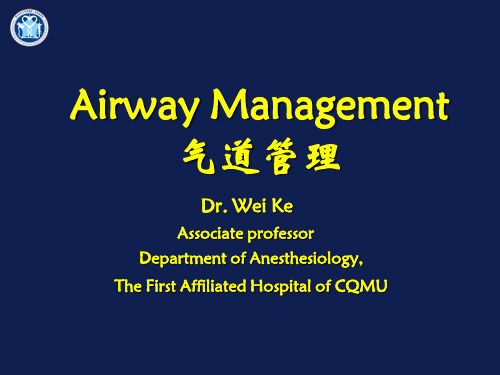
Interincisor gap 切牙间隙(?)
Definition 定义: The distance between the incisors when opening the mouth maximally 最大程度张嘴时切 牙间距离
Normal: ≥ 3.5cm or 3 fingers Small: < 3cm or 2 fingers
Mallampati classification 气道状况分类
Class I. Four structures are all visible. Class II. Hard and Soft palate, part of the uvula are visible Class III. Only hard and soft palate are visible Class IV. Only hard palate is visible. Class III and IV is predicted to be with risk of difficult Intubation
Forward Extension of Lower Jaw 下颚前伸
Normal 正常: ≥ the lower jaw extend beyond the upper jaw 下颚前伸超过上颚 Abnormal 异常: potential risk of difficult airway 潜在的 困难气道风险
• Diseases that may affect the airway open ቤተ መጻሕፍቲ ባይዱ响气道开放的疾 病
• Joint diseases of head and neck 头颈部关节疾病 • A previous history of difficult airway 困难气道既往史 • Previous surgical history in neck, throat, trachea and thyroid
急性呼吸衰竭护理查房总结范文

急性呼吸衰竭护理查房总结范文英文回答,Acute respiratory failure is a life-threatening condition that requires prompt and appropriate nursing care. During my assessment of the patient with acute respiratory failure, I observed the following:1. Respiratory status: The patient presented with dyspnea, increased respiratory rate, and use of accessory muscles for breathing. Oxygen saturation was low, and auscultation revealed decreased breath sounds and adventitious lung sounds such as crackles.2. Vital signs: The patient had an elevated heart rate and blood pressure, indicating increased sympathetic response due to hypoxemia. Temperature was within normal limits.3. Mental status: The patient appeared anxious and restless, which can be attributed to hypoxia and respiratory distress. Oxygenation to the brain may becompromised, leading to altered mental status.4. Skin color and condition: The patient had pale and cool skin, which can be a sign of poor tissue perfusion due to hypoxemia. Cyanosis was also observed in the lips and nail beds, indicating inadequate oxygenation.5. Chest X-ray findings: The chest X-ray showed bilateral infiltrates, indicating pulmonary edema or infection. This finding is consistent with the patient's symptoms and respiratory distress.Based on my assessment, the nursing interventions for a patient with acute respiratory failure would include:1. Airway management: Ensuring a patent airway is crucial in these patients. Administering supplemental oxygen via nasal cannula or mask can help improve oxygenation.2. Positioning: Elevating the head of the bed to asemi-Fowler's position can assist with lung expansion andimprove ventilation.3. Monitoring vital signs: Frequent monitoring of heart rate, blood pressure, respiratory rate, and oxygen saturation is essential to assess the patient's response to treatment and identify any deterioration.4. Medication administration: Administering bronchodilators, diuretics, and antibiotics as ordered can help improve lung function, reduce fluid overload, andtreat any underlying infection.5. Emotional support: Providing reassurance and calming techniques can help alleviate anxiety and promote relaxation, which can improve respiratory effort.中文回答:急性呼吸衰竭是一种危及生命的状况,需要迅速和适当的护理干预。
空气维他命疗养机
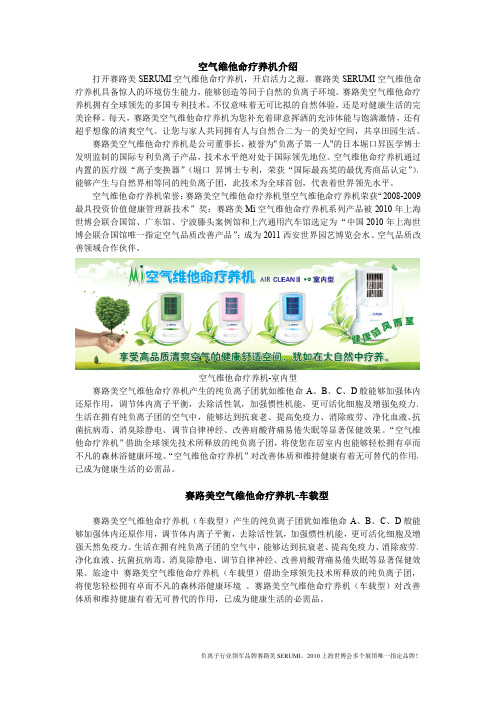
空气维他命疗养机介绍打开赛路美SERUMI空气维他命疗养机,开启活力之源。
赛路美SERUMI空气维他命疗养机具备惊人的环境仿生能力,能够创造等同于自然的负离子环境。
赛路美空气维他命疗养机拥有全球领先的多国专利技术,不仅意味着无可比拟的自然体验,还是对健康生活的完美诠释。
每天,赛路美空气维他命疗养机为您补充着肆意挥洒的充沛体能与饱满激情,还有超乎想像的清爽空气。
让您与家人共同拥有人与自然合二为一的美好空间,共享田园生活。
赛路美空气维他命疗养机是公司董事长,被誉为"负离子第一人"的日本堀口昇医学博士发明监制的国际专利负离子产品,技术水平绝对处于国际领先地位。
空气维他命疗养机通过内置的医疗级“离子变换器”(堀口昇博士专利,荣获“国际最高奖的最优秀商品认定”),能够产生与自然界相等同的纯负离子团,此技术为全球首创,代表着世界领先水平。
空气维他命疗养机荣誉:赛路美空气维他命疗养机型空气维他命疗养机荣获“2008-2009最具投资价值健康管理新技术”奖;赛路美Mi空气维他命疗养机系列产品被2010年上海世博会联合国馆、广东馆、宁波滕头案例馆和上汽通用汽车馆选定为“中国2010年上海世博会联合国馆唯一指定空气品质改善产品”;成为2011西安世界园艺博览会水、空气品质改善领域合作伙伴。
空气维他命疗养机-室内型赛路美空气维他命疗养机产生的纯负离子团犹如维他命A、B、C、D般能够加强体内还原作用,调节体内离子平衡,去除活性氧,加强惯性机能,更可活化细胞及增强免疫力。
生活在拥有纯负离子团的空气中,能够达到抗衰老、提高免疫力、消除疲劳、净化血液、抗菌抗病毒、消臭除静电、调节自律神经、改善肩酸背痛易倦失眠等显著保健效果。
“空气维他命疗养机”借助全球领先技术所释放的纯负离子团,将使您在居室内也能够轻松拥有卓而不凡的森林浴健康环境。
“空气维他命疗养机”对改善体质和维持健康有着无可替代的作用,已成为健康生活的必需品。
呼吸机机械通气操作流程
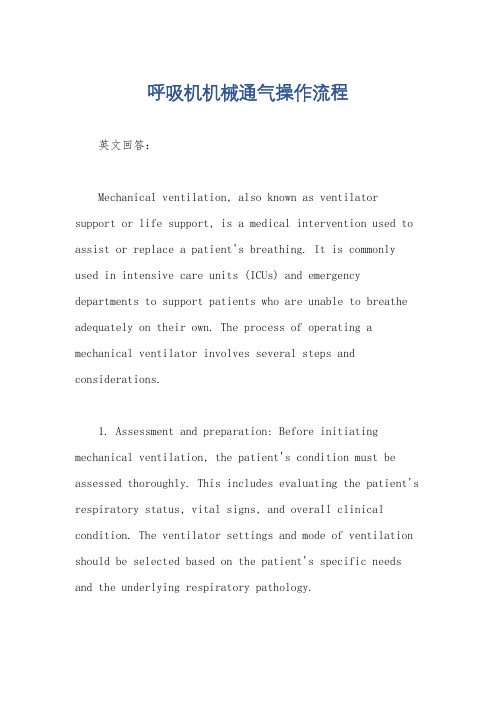
呼吸机机械通气操作流程英文回答:Mechanical ventilation, also known as ventilator support or life support, is a medical intervention used to assist or replace a patient's breathing. It is commonly used in intensive care units (ICUs) and emergency departments to support patients who are unable to breathe adequately on their own. The process of operating a mechanical ventilator involves several steps and considerations.1. Assessment and preparation: Before initiating mechanical ventilation, the patient's condition must be assessed thoroughly. This includes evaluating the patient's respiratory status, vital signs, and overall clinical condition. The ventilator settings and mode of ventilation should be selected based on the patient's specific needs and the underlying respiratory pathology.2. Airway management: Establishing a secure airway is crucial for mechanical ventilation. This can be achieved through endotracheal intubation or the use of asupraglottic airway device. Proper positioning of the endotracheal tube or airway device is essential to ensure effective ventilation.3. Ventilator setup: Once the airway is secured, the ventilator can be connected to the patient. The ventilator settings should be adjusted based on the patient's respiratory parameters, such as tidal volume, respiratory rate, and positive end-expiratory pressure (PEEP). The mode of ventilation, such as volume-controlled or pressure-controlled ventilation, should be selected based on the patient's condition.4. Monitoring and adjustments: Continuous monitoring of the patient's respiratory parameters is necessary to ensure adequate ventilation and oxygenation. This includes monitoring the patient's tidal volume, oxygen saturation, end-tidal carbon dioxide levels, and airway pressures. Any abnormalities or changes in these parameters should bepromptly addressed by adjusting the ventilator settings.5. Weaning and extubation: Once the patient's condition improves and they are able to breathe spontaneously, weaning from mechanical ventilation can be initiated. This involves gradually reducing the level of ventilator support and monitoring the patient's ability to maintain adequate ventilation and oxygenation. If the patient meets the criteria for successful weaning, extubation can be performed.6. Complications and troubleshooting: Mechanical ventilation can be associated with various complications, such as ventilator-associated pneumonia, barotrauma, and ventilator-induced lung injury. Monitoring and prevention of these complications are essential. In case of any issues or alarms from the ventilator, troubleshooting should be done promptly to ensure patient safety.中文回答:机械通气,也称为呼吸机支持或生命支持,是一种用于辅助或替代患者呼吸的医疗干预措施。
Airway Management(气道管理)
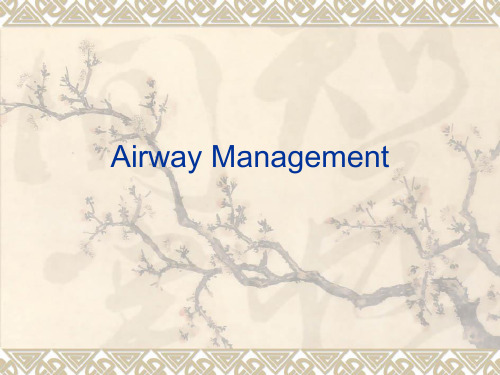
Bronchospasm
Incentives anaphylactoid drug and blood transfusion reactions , secretions and endotracheal intubation Symptoms and Signs Wheezing (usually more pronounced on expiration) tachypnea and dyspnea in the awake patient. difficult to ventilate in the anesthetized patient
Laryngospasm
Treatment When laryngospasm is less severe: Deepening the anesthetic level and removing the stimulus while administering 100% oxygen . Moderate spasm: continuous positive pressure on the airway with mask and a jaw thrust may relieve the spasm. severe spasm : use of muscle relaxants such as succinylcholine(琥珀胆碱), endotracheal intubation if necessary . The lungs should be ventilated with 100% oxygen, and either the anesthetic level should be deepened before the noxious stimulation is resumed or the patient may be allowed to awaken if laryngospasm has occurred during emergence
Airway Management气道管理
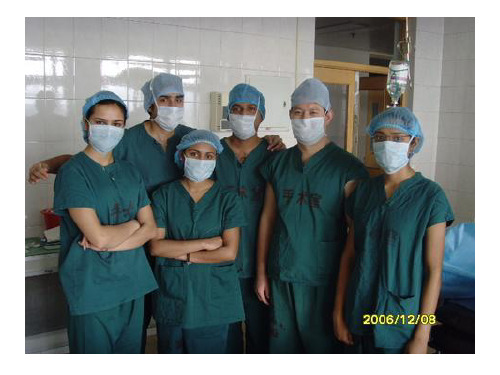
12
Technique
3. Airway obstruction
clinical manifestation:
Stridor and a ―rocking‖ motion of the chest and abdomen
No respiratory excursions in the reservoir bag Increased peak airway pressures
4
• METHODS OF AIRWAY MANAGEMENT
• EVALUATION OF THE AIRWAY
5
METHODS OF AIRWAY MANAGEMENT
• Mask airway • Laryngeal mask airway (LMA) • Endotracheal intubation
Technique——holding the mask with one hand
11
Technique——holding the mask with two hands
• • • When mask ventilation is difficult owing to upper airway obstruction, Two hands may be required to maintain a good mask fit A second operator may be required to control the reservoir bag Head straps may be used to assist mask fit.
16
upper airway obstruction
.
17
MASK AIRWAY —— Difficult Mask Ventilation
高级气道管理精要

急救员跪於伤病者侧面,接近头部。 一双手放於病者额前按下,手肘则稳定在地上。 另一手之食指及中指承托患者下巴尖骨边,然后向上提升。
注意:
可放置一 1-2cm 高的软垫於伤病者的肩下,效果更佳。
切勿托高伤病者的颈部,这对暢通气道毫无帮助,且可能令颈椎受损。
托颌法 (Jaw thrust)
手法技巧
5.0 – 5.5 5.5 – 6.0 6.0 – 6.5 6.5 – 7.0
不带囊
14 – 14.5
15 16 17 18 – 19
成年女 成年男
7.0 – 7.5* 7.5 – 8.0*
21 – 22# 22 - 23#
# 经鼻插管深度多2-3cm
* 经鼻插管选小0.5mm导管
喉内操作 Internal Laryngeal Manipulation
快速诱导插管 RSI
Preparation 准备期
Monitors 监视设备
血氧分析仪 心电图监视器 血压计 Pulse oximetry ECG monitor Blood pressure
二氧化碳侦测器 CO2 detector
快速诱导插管 RSI
处置流程
Seven P’s
Preparation Preoxygenation 准备期 预给氧期 10 分前钟前 5 分钟前
4 + 年龄/4
12 + 年龄/2
年龄
早产儿 足月儿
气管内径ID (mm)
2.5 – 3.0 3.0 – 3.5 不带囊 不带囊
插管深度 (cm)
8–9 10 – 11
1岁
2-3岁
4.5
5.0 - 5.5
不带囊
Airway Management, Ventilation, Oxygen Therapy:气道管理,通风,氧疗

Glottis
Kansas Airway Supplement Kansas BEMS EMS Educator Task Force
3
Respiratory Anatomy
Cricoid cartilage
Larynx (voice box). Bronchi Lungs – Visceral pleura (surface of lungs) – Parietal pleura (internal chest wall) – Interpleural space (potential space)
relax decreasing the size of the thoracic cavity.
– Diaphragm moves upward, ribs move downward and inward.
The positive pressure inside the chest
cavity causes air flow out of the lungs.
Kansas Airway Supplement Kansas BEMS EMS Educator Task Force 13
Opening the Airway
Head-tilt, chin lift maneuver – Adults vs.. Infants and Children
Jaw thrust maneuver
Kansas Airway Supplement Kansas BEMS EMS Educator Task Force 11
Infant and Child Considerations
人工气道的管理 英语
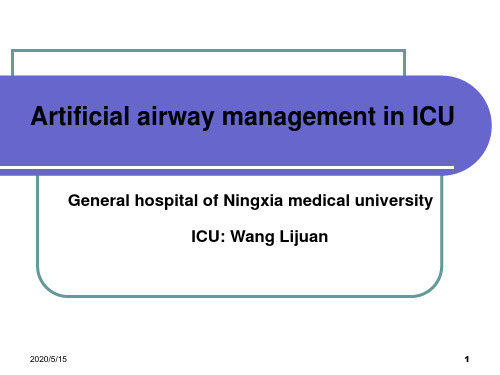
2013-8-21
20
南丁格尔格言
护士的工作对象不是冷冰冰的石块、木头和纸,而是有 热血和有生命的人类,护士的工作是精细艺术中之最精 细者,其中有一个原因,就是护士必须具有一颗同情的 心和一双愿意工作的手。
2013-8-21
22
The appropriate (最佳)
temperature of Suction(吸入)
gas is 32-36 degrees
2013-8-21 11
Bacterial filter(细菌过滤器)
Artificial nose: On the filtration of bacteria(清 除细菌) have certain effect, it
Another important things
Avoid(避免 )the pipeline water(积水瓶中的水) pouring (灌入) the artificial airway and timely pouring(倾倒).
To prevent the pipeline
distortion(打折), keep the pipelines unobstructed(通畅)
Airtight(密闭) Unobstructed (通畅)
The key(关键) and details(细节) — of airway management
Oral care:(口腔护理) Secure fixation(安全固定)
Teeth pad (牙垫)of nursing
keep airway unobstructed通畅 Body position:(体位) Prevent mucosal(粘膜) injury Click to add Title
成人危重症患者气道管理的最佳证据总结
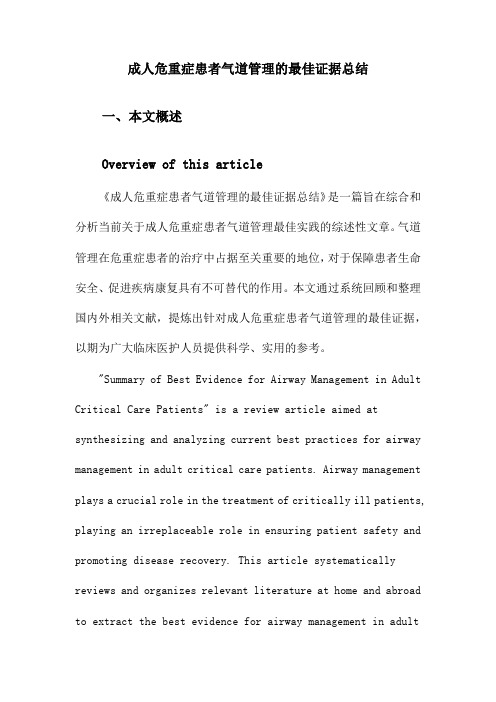
成人危重症患者气道管理的最佳证据总结一、本文概述Overview of this article《成人危重症患者气道管理的最佳证据总结》是一篇旨在综合和分析当前关于成人危重症患者气道管理最佳实践的综述性文章。
气道管理在危重症患者的治疗中占据至关重要的地位,对于保障患者生命安全、促进疾病康复具有不可替代的作用。
本文通过系统回顾和整理国内外相关文献,提炼出针对成人危重症患者气道管理的最佳证据,以期为广大临床医护人员提供科学、实用的参考。
"Summary of Best Evidence for Airway Management in Adult Critical Care Patients" is a review article aimed at synthesizing and analyzing current best practices for airway management in adult critical care patients. Airway management plays a crucial role in the treatment of critically ill patients, playing an irreplaceable role in ensuring patient safety and promoting disease recovery. This article systematically reviews and organizes relevant literature at home and abroad to extract the best evidence for airway management in adultcritically ill patients, in order to provide scientific and practical reference for clinical medical staff.本文将从以下几个方面对成人危重症患者气道管理的最佳证据进行总结:概述气道管理在危重症患者治疗中的重要性;分析气道管理过程中的关键环节和核心要素,包括气管插管、机械通气、气道湿化、气道吸引等内容;再次,结合最新研究成果,探讨气道管理的新理念、新技术和新方法;总结成人危重症患者气道管理的最佳实践,提出针对性的建议和改进措施。
常用“矿井通风与空气调节”英汉专业词汇

为了便于一些同学阅读矿井通风与空调方面的英文参考资料和为以后撰写英文论文发表,下面给出了一些常见的矿井通风与空调中英文专业词汇。
Abandoned workings 废弃坑道Absolute pressure 绝对压力Acceptable accuracy 允许精度Active regulation 主动调节(增压调节)Actual characteristic curves实际特征曲线Adiabatic and isentropic processes等熵线绝热的过程Adiabatic saturation process 绝热饱和过程Aerofoils风板Aerosol particles 气溶胶粒子Air crossings 风桥Air mover 鼓风机Air power空气动力Air pressure management 风压管理Air quantity survey空气质量调查Air regulators 风窗Airborne pollutants空气污染物Airflow measurements 风流测定Airflow reversal反向风流Airlock 气闸Airlocks 风门Airway resistance curve风路阻力曲线Alpha, beta and gamma radiation阿尔法、贝塔和伽玛辐射Altimeters 高度计Angular velocity角速度Asbestos 石棉Atkinson equation阿特金森方程式Atmospheric conditions 大气状态Atmospheric pressure 大气压力Auxiliary ventilation 辅助通风Axial fan轴流风机Axial impeller轴向式叶轮Backfill material 充填材料Barometers 气压计Barometric pressure at inlet 入口气压Becquerel (Bq) 贝克勒尔Bernoulli's equation for ideal fluids 理想流体伯努力方程Biot number 比奥数Blackdamp 窒息气体Blast fume炮烟Booster fans 局扇Boreholes 钻孔Branch resistance分支阻力Branch tree分支树Brattice curtain 风帘Brattices 风帘Bronchioles 细支气管Brownian motion 布朗运动Buoyancy (natural draft) effect浮力作用Burying the fire掩埋火源Cage and skip 罐笼和箕斗Carbon dioxide produced生成二氧化碳Carbon dioxide 二氧化碳Carbon monoxide 一氧化碳Carcinogenic (cancer causing) dusts 致癌粉尘Carnot cycle 卡诺循环Centrifugal fan离心风机Centrifugal impeller离心叶轮Chemical absorption化学吸收Chézy-Darcy equation谢兹-达西方程Chilled water spray chamber 冷却液体喷雾室Choke effect瓶颈效应Circular airway 循环风路Closed loop闭环Closed path回路Coal workers' pneumoconiosis (CWP) 煤工尘肺病Coefficient of drag阻力系数Coefficient of dynamic viscosity动力粘度系数Coefficient of friction摩擦系数Compressed air-assisted sprays 压气助喷雾Compressible flow可压缩流Computational fluid dynamics计算流体力学Condenser cooling tower 凝气器降热塔Condenser 冷凝器Consolidation 固结Contaminants 污染物Continuity equation 连续方程Controlled partial recirculation 受控开路循环通风Controlled recirculation in headings 掘进面受控循环通风Convected energy 扩散能Convective heat transfer 对流换热Conveyance运输工具Copper orebody 铜矿体Cross section of a duct or airway 管道或风路断面Curie, Ci 居里Cylindrical cyclone重力旋流器Dealing with a spontaneous heating 处理自热Degrees Celsius 摄氏度Degrees Kelvin绝对温度Density of gases 气体密度Desorption kinetics解吸动力学Dew point hygrometers 露点毛发湿度计Diaphragm gauge 隔膜片仪表Diesel emissions柴油机排放物Diesel exhaust fume柴油机尾气Diesel particulate matter柴油机颗粒物质Differential pressure instruments 微压差计Dimensionless无量刚Disaster management 灾害管理District systems 分区通风系统Dose rates 剂量率Downcast shaft入风井Droplet diameter雾滴直径Duct system风管系统Dust suppression 降尘Dynamic behavior of molecules 分子运动特征Electrochemical methods电化学方法Electrostatic precipitators 电除尘器Emanation of radon 氡的辐射Empirical method 经验方法Energy recovery device 能量回收装置Enthalpy of moist air潮湿空气的焓Enthalpy 焓Entry and exit losses 入口和出口阻力损失Environmental engineering 环境工程Equivalent length当量长度Equivalent resistance等效风阻Equivalent resistance等效阻力Equivalent sand grain roughness相当砂粒粗糙度Escape way 逃生通道;安全通道Euler's equation欧拉方程Evaporator蒸发器Excavating the fire挖掘火源Exhausting air 抽出空气Exhausting system 抽出式通风系统Explosive dusts 爆炸粉尘Explosives炸药Fan characteristic curve风机特征曲线Fan maintenance 风机维护Fan performance 风机性能Fan static pressure风机静压Fan total pressure风机全压Fan velocity pressure风机速度压Fibrogenic dusts 矿渣粉尘Filament and catalytic oxidation (pellistor) detectors丝状催化氧化探测器Fire triangle 火三角Firedamp 甲烷Firefighting with water 以水灭火First law of thermodynamics 热力学第一定律Fixed point measurement固定点测量Fixed quantity branch固定风量分支Flame safety lamps灯具安全火焰Flexible tubing 柔性风筒Flooded orifice scrubber 水淹孔洗涤器Flooding and sealing off 溢出和密封作用Flow work 流动功Fluid mechanics 流体力学Fluid pressure 流体压力Fog 雾Fogged air 雾气Forcing air压入空气Forcing or blowing system 压入式通风系统Fourier number傅里叶数Fragmented rock 破碎岩石Free crystalline silica (quartz, sand stones, flint)游离硅晶体Friction factor摩擦系数Frictional flow 摩擦流动Frictional losses摩擦损失Frictional pressure drop摩擦压降Frictional resistance 摩擦阻力Frictionless manner 无摩擦状态Gas adsorbents 气体吸收剂Gas chromatography气相色谱Gas constants 气体常数Gas drainage 瓦斯抽放Gas laws 气体定律Geothermic gradient 地热梯度Gob drainage采空区抽放气体Grab samples 样品收集Gravitational field 重力场Gravitational settlement of particles 引力沉降颗粒Gravitational settlement 重力沉降Hair hygrometers 毛发湿度计Hardy-Cross technique哈代克劳斯技术Haulage airways 运输风路Haulage level 运输平巷Heat capacity 热容Heat cramps 中暑痉挛Heat diffusivity 热扩散系数Heat exchanger 换热器Heat exchange换热Heat exhaustion 热量消耗Heat fainting 热昏厥Heat flux 热通量Heat illness 中暑Heat rash 热疹Heat stroke 中暑Heat tolerance 耐热性Heat transfer coefficient 传热系数High expansion foam高倍数泡沫High pressure tapping高压测压孔Hoisting shaft提升竖井Hot wire anemometer热线风速仪Hydraulic radius水力半径Hydrogen sulfide硫化氢气Hydrolift system 水力提升系统Hydropower 水电Ice system 冷却系统Ideal gas 理想空气Ideal isothermal compression理想恒温压缩Immediate response 应急反应Induction 感应Industrial Hygienists 工业卫生学家Inhalation rate吸入速度Initiation of explosions引发爆炸Injection of inert gases注射惰性气体Inlet and outlet ducts入口和出口管In-situ measurement 现场测量Intake airway 进风风路Interception and electrostatic precipitation 截留和静电沉淀Interference factor干扰因素Interferometers干涉计Internal Energy 内能Ionization smoke detectors离子感烟探测器Iron pyrites黄铁矿Jet fan 射流风机Junction节点Kata thermometer 卡它计Kinetic energy 动能Kirchhoff's Laws 基尔霍夫定律Laminar and turbulent flow层流和紊流Laminar resistance 层流阻力Laminar sublayer层流次边界层Laser spectroscopy激光光谱学Latent (or hidden) heat of the air空气的潜热Layout of mine 矿井布置Leakage control漏风控制Legislation 法规Level workings阶段工作面Loading station装运站Longitudinal fittings纵向装备Longwall长壁开采法Machine mounted gas monitors悬挂式气体检测器Main fans 主扇Main haulage route主运输道Main return 主(总)回风道Manometers 压差计Mass flow 质量流量Mass spectrometers质谱仪Mean free path 平均自由程Mean velocity of air 平均风速Mesh selection网孔选择Mesh网Metabolic heat balance 代谢热量平衡Metabolic heat代谢热Metal mine fires金属矿井火灾Meteorology 气象Methane drainage瓦斯排放Methane 甲烷Method of mining 采矿方法Mine climate 矿井气候Mine resistance 矿井阻力Mine ventilation 矿井通风Mist eliminator 除雾器Mist 雾Moisture content (specific humidity) of air空气的含湿量Momentum 动量Monitoring systems 监测系统Moving traverses运动线路Natural ventilating effect自然通风影响Natural ventilation 自然通风Neutral skin temperature 中性表皮温度Nikuradse's curves 尼库拉则曲线Nondispersive infra-red gas analyzer非分散红外线气体分析仪Nuisance dusts 粉尘污染Numerical method数值方法Nusselt number努塞尔数Old workings老工作面One standard atmosphere 一个标准大气压Open and concealed fires 明火和隐蔽火灾Ore pass 放矿溜井Ore production矿石生产Orebody deposit 矿体Outbursts from roof and floor 顶板和底板瓦斯突出Overlap systems of auxiliary ventilation 混合式局部通风Oxides of nitrogen氧化氮Oxygen Consumption耗氧量Parallel network or circuit并联网络或回路Paramagnetic analyzer 顺磁分析仪Passive regulator 可调风窗Pellistor methanometers瓦斯检定器Peripheral velocity圆周速度Permanent environmental monitors 持久环境监控Permeability 渗透率Personal dosemeters 个人剂量计Personal respirators 个体呼吸器Phases of oxidation氧化反应阶段Photometric (light-scattering) methods 分光光度Physical adsorption物理吸附Physical thermodynamics 物理热力学Pick face flushing and jet-assisted cutting 锯齿面冲洗与喷气助推器切割Piezoelectric instruments 压电仪器Pitot-static tube皮托静压管Polyvinyl chloride (PVC)聚氯乙烯Potential energy 势能Prandtl number 普兰特尔数Precautions against spontaneous combustion自燃预防Pressure energy 压能Pressure head 压头Pressure surveys压力调查Pressure transducers 压力传感器Pressure-volume surveys压力容积测量Profilometer轮廓仪Psychrometric chart 温湿图Psychrometric measurements 干湿度测量Push-pull system 压-抽混合式通风系统Radial velocity径向速度Radiation 辐射Radiative heat transfer 辐射传热Radioactive decay and half-life放射衰变和半衰期Radon daughters氡子体Radon decay constant 氡的衰变常数Radon, Rn氡气Ramp 斜坡道Rates of heat production 生产率Rates of oxygen consumption 氧气消耗率Refrigerant fluid 制冷液Refrigeration cycle制冷循环Refrigeration systems 制冷系统Refuge chambers避难洞室Regulator 调节器Relative humidity and percentage humidity相对湿度和湿度率Removal of dust from air 气体除尘Re-opening a sealed area重开封闭区Respirable dust呼吸性粉尘Respiratory system 呼吸系统Return airway 回风巷Reynolds Number雷诺数Room and pillar房柱式Rotating vane anemometer旋转叶片风速表Rough pipes 粗管Roughness粗糙度Safety and Health 安全卫生Saturation vapor pressure 饱和蒸汽压Sealants密封剂Seals 密闭Second law of thermodynamics 热力学第二定律Self-heating temperature (SHT) 自热温度Self-rescuers 自救器Sensible heat of the air 空气的显热Series network or circuit串连网络或回路Shaft fittings 井筒装备Shaft wall井壁Shear stress 剪切应力Shock loss factor冲击损耗系数Shock losses 冲击损失Short-Term Exposure Limit (STEL) 短时间接触阈限值SI system of units 国际标准单位体系Sigma heat 西格玛热Smoke tube烟筒Smoking and flame safety lamps 烟火安全灯Smooth concrete lined光滑混凝土内衬Specific heat (thermal capacity)比热容Specific heats 比热Spontaneous combustion of sulfide ores硫化矿自燃Spontaneous combustion自燃Spontaneous heating 自热Spot cooler 现场冷却器Spray fan 喷雾风机Steady flow energy equation稳流能量方程Steady flow physical thermodynamics稳流物理热力学Steady-flow thermodynamics 稳定流热力学Stokes' diameter斯托克斯粒径Stoping areas 回采区Stoppings 密闭Subsurface openings 地下空间Subsurface ventilation 地下通风Sulfide dust explosions 硫化矿粉尘爆炸Sulfur dioxide二氧化硫Sulfuric acid vapor硫酸雾Swinging vane anemometer摆动叶片风速表Tangential velocity at outlet出口切向速度Temperature-entropy diagram温熵图Temporary stopping暂时停止Terminal velocities 自由沉降速度The square law平方定律Thermal conductivity of insulation 绝缘导电温度Thermal conductivity导热系数Thermal equilibrium 热平衡Thermodynamic state 热力学状态Thermoluminescent dosemeters (TLD) 热释光剂量计Thermoregulation 体温调节Threshold limit values (TLV) 阈限值Through-flow ventilation 贯穿通风Time-Weighted Average (TWA)时间加权平均Total energy balance 总能量守恒Total shaft resistance 井筒总阻力Tube bundle systems 管束系统Turbulent resistance紊流阻力U tube manometers U型压差计U tube U型管Uncontrolled recirculation 无控循环通风Underground ventilation system 地下通风系统Unloading station卸载站Upcast shaft出风井Uranium mines 铀矿Vasodilation 血管舒张Velocity contour等流速线Velocity limit速度限值Velocity pressures 动压Velometer速度计Ventilation circuit 通风回路Ventilation door 风门Ventilation engineers 通风工程师Ventilation network analysis通风网络分析Ventilation planning 通风设计Ventilation raise 通风天井Ventilation survey team 通风测量术语Ventilation survey通风测量Venturi scrubber文丘里洗涤器Vertex顶点Viscosity 粘度Viscous drag粘性阻力Volume flow 体积流量Volumetric efficiency 容积效率Vortex-shedding anemometer漩涡式风速表Water gauge pressure 水柱压力Water infusion 注水(水封孔)Water mass flowrate 水质量流量Water vapor content 水蒸气含量Wet and dry bulb hygrometers (psychrometers)干湿球温度表Wet bulb thermometer 湿球温度计Wet Kata thermometer湿球卡他温度表Wet scrubbers湿式除尘器Wetting agents 润湿剂Worked-out area采空区Working face工作面Working level month, WLM 工作水平月Working Level 开采水平Zinc blende闪锌矿——上述词汇摘录自:吴超主编。
气管插管-住院医师版2013.6
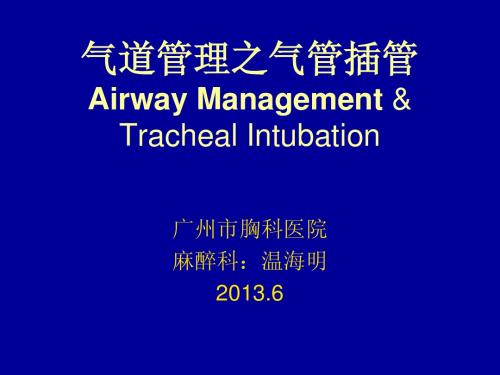
步骤7、再确认位置、固定导管
望胸廓隆起、听双肺呼吸音是否对称,剑突下水泡音? 监护仪(SpO2 %,EtCO2mmHg) 误入单侧肺?食道?
入镜、插管拔芯、退镜入牙垫, 初步判断导管
套囊充气、供氧气、固定、再确认 导管
并发症及预防
• 表面麻醉或全麻不足:剧烈咳嗽、憋气或 喉支气管痉挛。有时由于迷走神经过度兴 奋而产生心动过缓、心律失常,甚至心跳 骤停;有时会引起血压剧升。
4c上提喉镜会厌起露声门
提起喉镜时着力点
• 切记:提起喉镜时着力 点住在喉镜的顶端, 切忌以上门齿作为着 力点。
• 牙齿脱落索赔2千 • 鼻梁塌陷索赔2万
步骤5右手执笔抓导管插入导管
• • •
•
对着声门置入导管, 仅见会厌,管端贴其 后面插。 困难插管,需纤支镜 下或者盲探插。 管过声门拔除管芯
1、病人具体情况(适应症)
• • • • • • 年龄性别, 神智(昏迷清醒), 饮食饱胃, 心血管疾病, 牙齿、鼻 口咽喉现在及手术史,张 口度(正常三横指,Ⅰ度, Ⅱ度,Ⅲ度困难), • 颈椎活动度(正常前 165°后>90°<80°为 后仰困难)后仰越大越好
2、插管前准备(9种)
• • • • • • • • 喉镜、 导管及管芯、 注射器、 牙垫、 固定、 呼吸囊、 吸引器、 麻醉或镇静另外还有肌松 药。 • 垫枕
气道管理Airway Management
• 目的:建立通畅气道 和有效的氧合、防止缺氧。 采用哪种供氧方法?由简 单到复杂,先无创后有创 路径是从口、鼻、气管切 开。
Ventilation via mask airway • oropharyngeal airway, nasopharyngeal airway • laryngeal mask airway (LMA) • Tracheal intubation
Airway_Management(气道管理)详解
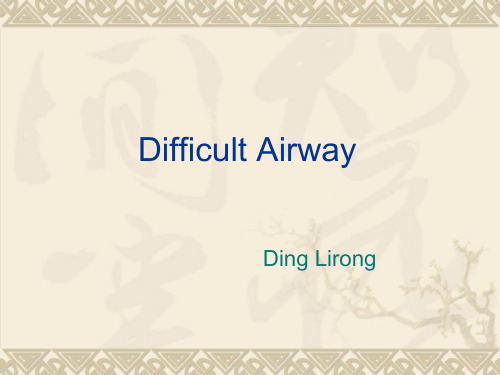
Evaluation of Difficult Airway
Physical examination :
Specific findings that may indicate a difficult airway include the following: Inability to open the mouth(<1.5cm) Poor cervical spine mobility. thyromental distance is less than 6 cm Receding chin (micrognathia). Large tongue (macroglossia). Prominent incisors. Short muscular neck. Morbid obesity
Difficult Airway
Ding Lirong
Difficult Airway
Definition : The formal training anesthesiologist or doctors in emergency and ICU fail to ventilate patients by mask or intubate patients with conventional laryngoscopy . The ASA defines a difficult airway as failure to intubate with conventional laryngoscopy after three attempts and/or failure to intubate with conventional laryngoscopy for more than 10 min.
俯卧位通气的操作流程评分标准

俯卧位通气的操作流程评分标准英文回答:Scoring criteria for prone ventilation procedure:1. Patient preparation: This step involves ensuring the patient's safety and comfort before initiating the prone ventilation procedure. It includes checking the patient's vital signs, securing intravenous access, and providing adequate sedation and analgesia. The patient's skin should be protected using appropriate padding to prevent pressure ulcers.2. Positioning: Proper positioning of the patient is crucial for effective prone ventilation. The patient should be placed in a prone position with the head turned to one side to facilitate intubation and airway management. The limbs should be appropriately supported to maintain proper alignment and prevent injury.3. Airway management: Ensuring a patent airway is essential during prone ventilation. The endotracheal tube or tracheostomy should be properly secured, and the cuff pressure should be monitored regularly. Adequate suctioning of the airway should be performed as needed to maintain clear air passages.4. Ventilator settings: The ventilator settings should be adjusted to optimize oxygenation and ventilation in the prone position. This includes adjusting the tidal volume, respiratory rate, positive end-expiratory pressure (PEEP), and FiO2 levels based on the patient's condition andarterial blood gas analysis.5. Monitoring and assessment: Continuous monitoring of the patient's vital signs, oxygenation, and ventilation is crucial during prone ventilation. This includes monitoring heart rate, blood pressure, oxygen saturation, end-tidal CO2, and arterial blood gases. Regular assessment of lung compliance and chest auscultation should also be performed.6. Complication management: Prompt identification andmanagement of complications associated with prone ventilation are essential. These may include pressure ulcers, accidental extubation, pneumothorax, or ventilator-associated lung injury. Proper measures should be taken to prevent and manage these complications.7. Team communication and coordination: Effective communication and coordination among the healthcare team members are vital during prone ventilation. Clear communication of patient status, ventilator settings, and any changes in the patient's condition should be ensured to promote efficient teamwork and patient safety.Scoring criteria for the prone ventilation procedure may include assessing the healthcare professional's ability to perform each step accurately and efficiently, as well as their ability to manage any complications that may arise. The score may be based on factors such as patient safety, proper positioning, airway management, ventilator settings, monitoring and assessment, complication management, and effective team communication.中文回答:俯卧位通气操作流程的评分标准:1. 患者准备,在开始俯卧位通气程序之前,确保患者的安全和舒适非常重要。
呼吸科护士自我评价简短50字
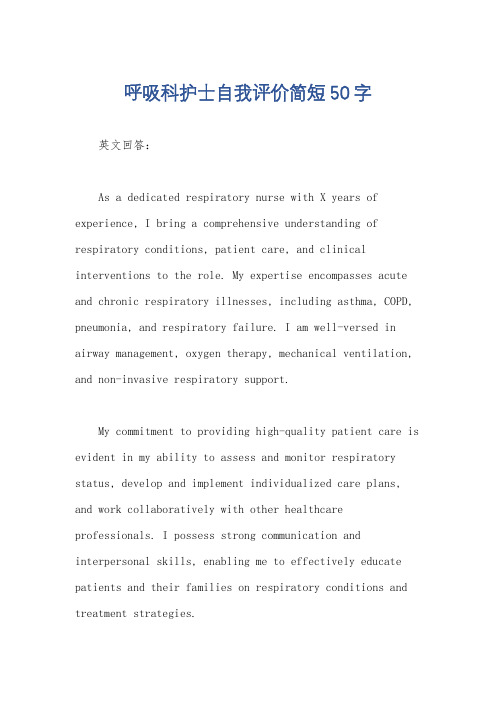
呼吸科护士自我评价简短50字英文回答:As a dedicated respiratory nurse with X years of experience, I bring a comprehensive understanding of respiratory conditions, patient care, and clinical interventions to the role. My expertise encompasses acute and chronic respiratory illnesses, including asthma, COPD, pneumonia, and respiratory failure. I am well-versed in airway management, oxygen therapy, mechanical ventilation, and non-invasive respiratory support.My commitment to providing high-quality patient care is evident in my ability to assess and monitor respiratory status, develop and implement individualized care plans, and work collaboratively with other healthcare professionals. I possess strong communication and interpersonal skills, enabling me to effectively educate patients and their families on respiratory conditions and treatment strategies.Furthermore, I am an active participant in continuing education and professional development, ensuring that my knowledge and skills remain up-to-date with the latest advancements in respiratory care. I am proficient inutilizing electronic medical records and other technologies to enhance patient care and streamline workflows.My dedication to excellence and compassion has consistently resulted in positive patient outcomes and high levels of patient satisfaction. I am eager to contribute my expertise and passion for respiratory care to your organization and continue to make a meaningful differencein the lives of patients with respiratory conditions.中文回答:作为一名拥有 X 年经验的敬业的呼吸科护士,我对呼吸系统疾病、患者护理和临床干预有着全面的了解。
简述呼吸机的使用流程
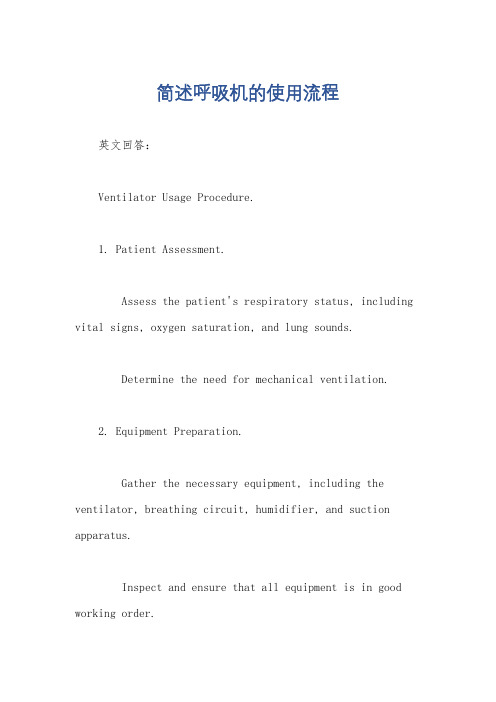
简述呼吸机的使用流程英文回答:Ventilator Usage Procedure.1. Patient Assessment.Assess the patient's respiratory status, including vital signs, oxygen saturation, and lung sounds.Determine the need for mechanical ventilation.2. Equipment Preparation.Gather the necessary equipment, including the ventilator, breathing circuit, humidifier, and suction apparatus.Inspect and ensure that all equipment is in good working order.3. Patient Positioning.Position the patient supine, with the head of the bed elevated 30-45 degrees.Place a pillow under the patient's head and shoulders to maintain airway patency.4. Airway Management.Insert an appropriate airway, such as an endotracheal tube or tracheostomy tube.Secure the airway securely and check for proper placement.5. Ventilator Setup.Connect the breathing circuit to the patient's airway and the ventilator.Set the ventilator parameters according to the patient's respiratory needs, including tidal volume, respiratory rate, and inspiratory-to-expiratory ratio.6. Monitoring.Monitor the patient's vital signs, oxygen saturation, and ventilator settings closely.Observe the patient for signs of respiratory distress or complications.7. Adjustments.Adjust the ventilator settings as needed based on the patient's condition.Titrate ventilator parameters to achieve the desired clinical outcomes.8. Weaning.Gradually reduce ventilator support as thepatient's condition improves.Assess the patient's ability to breathe spontaneously before extubation.9. Extubation.Remove the airway when the patient is stable and able to breathe adequately without ventilatory support.Provide supplemental oxygen as needed.中文回答:呼吸机使用流程。
气道通气的识别和评估(英文)
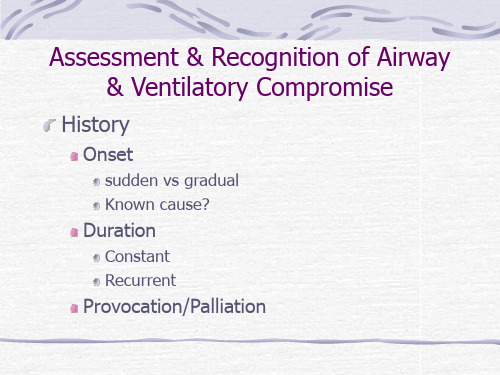
Airway & Ventilation Methods: BLS
Oxygen source
compressed gas liquid oxygen
Delivery Devices
nasal cannula partial rebreather mask non-rebreather mask venturi mask small volume nebulizer
Airway & Ventilation Methods: BLS
Gastric Distention
Common when ventilating without intubation pressure on diaphragm resistance to BVM ventilation increase time of BVM ventilation
Cough, chest pain, fever
Assessment & Recognition of Airway & Ventilatory Compromise
Interventions
past evals/admits meds ever intubated before?
Assessment & Recognition of Airway & Ventilatory Compromise
Airway & Ventilation Methods: ALS
Orogastric Tube Insertion (cont)
Assess placement & secure
instill air or aspirate
Evacuate contents as needed
- 1、下载文档前请自行甄别文档内容的完整性,平台不提供额外的编辑、内容补充、找答案等附加服务。
- 2、"仅部分预览"的文档,不可在线预览部分如存在完整性等问题,可反馈申请退款(可完整预览的文档不适用该条件!)。
- 3、如文档侵犯您的权益,请联系客服反馈,我们会尽快为您处理(人工客服工作时间:9:00-18:30)。
relax decreasing the size of the thoracic cavity.
– Diaphragm moves upward, ribs move downward and inward.
2
Respiratory Anatomy
Cricoid cartilage Larynx (voice box). Bronchi Lungs
– Visceral pleura (surface of lungs) – Parietal pleura (internal chest wall) – Interpleural space (potential space)
Oxygenation - blood and the cells become saturated with oxygen
Hypoxia - inadequate oxygen levels in the blood
Signs of Hypoxia
– Increased or decreased heart rate – Altered mental status (early sign) – Agitation – Initial elevation of B.P. followed by a decrease – Cyanosis (often a late sign)
Upper airway Lower airway Head/neck-Brain Spinal cord Chest wall
Kansas Airway Supplement
Kansas BEMS EMS Educator Task Force
ห้องสมุดไป่ตู้
7
Respiratory Physiology
Pharynx - infant’s and children’s tongues take up proportionally more space in the mouth than adults.
Trachea - (windpipe)
– Infants and children have narrower tracheas that are obstructed more easily by swelling.
Airway-Management-Ventilation--Oxygen-Therapy
:气道管理-通风-氧疗
Upper Airway
Epiglottis Tongue
Glottis
Kansas Airway Supplement
Kansas BEMS EMS Educator Task Force
Kansas Airway Supplement
Kansas BEMS EMS Educator Task Force
9
Infant and Child Considerations
Mouth and nose - generally all structures are smaller and more easily obstructed than in adults.
Cricoid cartilage - like other cartilage in the infant and child, the cricoid cartilage is less developed and less rigid. It is the narrowest part of the infant’s or child’s airway.
The positive pressure inside the chest cavity causes air flow out of the lungs.
Kansas Airway Supplement
Kansas BEMS EMS Educator Task Force
6
Anatomical sources of ventilation problems
Diaphragm Inhalation (active process)
– Diaphragm and intercostal muscles contract, increasing the size of the thoracic cavity.
– Diaphragm moves slightly downward, ribs move upward and outward.
Kansas Airway Supplement
Kansas BEMS EMS Educator Task Force
8
Alveolar Gas Exchange
Oxygen-rich air enters the alveoli during each inspiration.
Oxygen enters the blood in the capillaries as carbon dioxide enters the alveoli for exhalation.
Kansas Airway Supplement
Kansas BEMS EMS Educator Task Force
3
Lower Airway
Kansas Airway Supplement
Kansas BEMS EMS Educator Task Force
4
Respiratory Anatomy
The negative pressure in the chest cavity causes air flow into the lungs.
Kansas Airway Supplement
Kansas BEMS EMS Educator Task Force
5
Respiratory Anatomy
– Trachea is softer and more flexible in infants and children.
Kansas Airway Supplement
Kansas BEMS EMS Educator Task Force
10
Infant and Child Considerations
